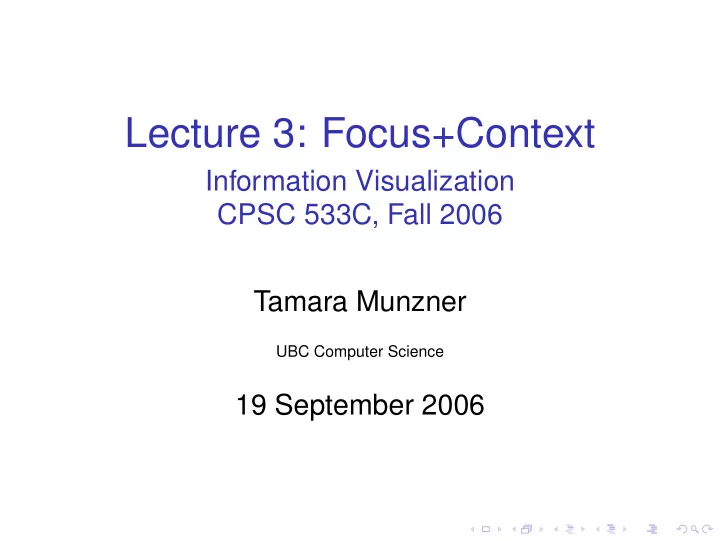

Lecture 3: Focus+Context Information Visualization CPSC 533C, Fall 2006 Tamara Munzner UBC Computer Science 19 September 2006
Papers Covered A Review and Taxonomy of Distortion-Oriented Presentation Techniques. Y.K. Leung and M.D. Apperley, ACM Transactions on Computer-Human Interaction, Vol. 1, No. 2, June 1994, pp. 126-160. [http://www.ai.mit.edu/people/jimmylin/papers/Leung94.pdf] Nonlinear Magnification Fields. Alan Keahey, Proc InfoVis 1997 [http://citeseer.nj.nec.com/keahey97nonlinear.html] The Hyperbolic Browser: A Focus + Context Technique for Visualizing Large Hierarchies. John Lamping and Ramana Rao, Proc SIGCHI ’95. [http://citeseer.nj.nec.com/lamping95focuscontext.html] H3: Laying Out Large Directed Graphs in 3D Hyperbolic Space. Tamara Munzner, Proc InfoVis 97 [http://graphics.stanford.edu/papers/h3/] TreeJuxtaposer: Scalable Tree Comparison using Focus+Context with Guaranteed Visibility. Munzner, Guimbretiere, Tasiran, Zhang, and Zhou. SIGGRAPH 2003. [http://www.cs.ubc.ca/˜tmm/papers/tj/] hyperbolic geometry background, if time
Focus+Context Intuition ◮ move part of surface closer to eye ◮ stretchable rubber sheet ◮ borders tacked down ◮ merge overview and detail into combined view
Bifocal Display transformation magnification 1D 2D
Perspective Wall transformation magnification 1D 2D
Polyfocal: Continuous Magnification transformation magnification 1D 2D
Fisheye Views: Continuous Mag transformation magnification 1D 2D rect polar norm polar
Multiple Foci same params diff params polyfocal magnification function dips allow this
Nonlinear Magnification ◮ transformation ◮ distortion ◮ magnification ◮ derivative of transformation ◮ directionality ◮ easy: given transformation, compute magnification ◮ differentiation ◮ hard: given magnification, compute transformation ◮ integration ◮ new mathematical framework ◮ approximate integration, iterative refinement ◮ minimize error mesh
Expressiveness ◮ magnification is more intuitive control ◮ allow expressiveness, data-driven expansion
2D Hyperbolic Trees ◮ fisheye effect from hyperbolic geometry [video]
3D Hyperbolic Graphs: H3 ◮ spanning tree backbone for quasi-hierarchical graphs video
Graph Layout Criteria good bad ◮ minimize ◮ crossings, area, bends/curves
Graph Layout Criteria good bad ◮ minimize ◮ crossings, area, bends/curves ◮ maximize good bad ◮ angular resolution, symmetry
Graph Layout Criteria good bad ◮ minimize ◮ crossings, area, bends/curves ◮ maximize good bad ◮ angular resolution, symmetry ◮ most criteria NP-hard ◮ edge crossings (Garey and Johnson 83)
Graph Layout Criteria good bad ◮ minimize ◮ crossings, area, bends/curves ◮ maximize good bad ◮ angular resolution, symmetry ◮ most criteria NP-hard ◮ edge crossings (Garey and Johnson 83) max symmetry min cross ◮ incompatible ◮ (Brandenburg 88)
Layout A B ◮ problem C G E ◮ general problem is NP-hard D F
Layout A B ◮ problem C G E ◮ general problem is NP-hard D F ◮ solution ◮ tractable spanning tree backbone A ◮ match mental model ◮ quasi-hierarchical B C ◮ use domain knowledge to construct D E F G ◮ select parent from incoming links
Layout A B ◮ problem C G E ◮ general problem is NP-hard D F ◮ solution ◮ tractable spanning tree backbone A ◮ match mental model ◮ quasi-hierarchical B C ◮ use domain knowledge to construct D E F G ◮ select parent from incoming links A A ◮ non-tree links on demand B C B C D E F G D E F G
Avoiding Disorientation ◮ problem ◮ maintain user orientation when showing detail ◮ hard for big datasets ◮ exponential in depth ◮ node count, space needed global overview local detail jerboa aardvark A−B baboon first capybara kangaroo C−D dodo the K−L elephant E−F lion ferret second gibbon G−H almost hamster mongoose iguana I−J jerboa third M−N kangaroo K−L lion nutria quick mongoose M−N nutria fourth orangutang orangutang tiptop O−P possum O−P quail possum Q−R rabbit fifth scorpion S−T tapir brown quail unicorn U−V viper sixth Q−R whale done W−X x−beast rabbit yellowtail Y−Z zebra seventh scorpion Anteater a−b Badger S−T fox Caiman c−d tapir Dog eighth Earthworm e−f Flamingo
Overview and detail ◮ two windows: add linked overview ◮ cognitive load to correlate
Overview and detail ◮ two windows: add linked overview ◮ cognitive load to correlate ◮ solution ◮ merge overview, detail ◮ focus+context
Noneuclidean Geometry ◮ Euclid’s 5th Postulate ◮ exactly 1 parallel line ◮ spherical ◮ geodesic = great circle ◮ no parallels (torus.math.uiuc.edu/jms/java/dragsphere) ◮ hyperbolic ◮ infinite parallels
Parallel vs. Equidistant ◮ euclidean: inseparable ◮ hyperbolic: different
Exponential Amount Of Room room for exponential number of tree nodes 2D hyperbolic plane embedded in 3D space hemisphere area hyperbolic: exponential 2 π sinh 2 r euclidean: polynomial 2 π r 2 [Thurston and Weeks 84]
Models, 2D Klein/projective Poincare/conformal Upper Half Space [Three Dimensional Geometry and Topology, William Thurston, Princeton University Press] Minkowksi
1D Klein hyperbola projects to line image plane eye point
2D Klein hyperbola projects to disk (graphics.stanford.edu/papers/munzner thesis/html/node8.html#hyp2Dfig)
Klein vs Poincare ◮ Klein ◮ straight lines stay straight ◮ angles are distorted ◮ Poincare ◮ angles are correct ◮ straight lines curved ◮ graphics ◮ Klein: 4x4 real matrix ◮ Poincare: 2x2 complex matrix
Upper Half Space ◮ cut and unroll Poincare ◮ one point on circle goes to infinity [demo: www.geom.umn.edu/˜crobles/hyperbolic/hypr/modl/uhp/uhpjava.html]
Minkowski 1D 2D [www-gap.dcs.st-and.ac.uk/˜history/Curves/Hyperbola.html] [www.geom.umn.edu/˜crobles/hyperbolic/hypr/modl/mnkw/] the hyperboloid itself embedded one dimension higher
Models, 3D ◮ 3-hyperbola projects to solid ball ◮ Upper Half Space ◮ Minkowski Klein/projective Poincare/conformal insider [graphics.stanford.edu/papers/webviz/]
3D vs. 2D Hyperbolic Scalability ◮ information density: 10x better H3 PARC Tree center fringe thousands 3D dozens hundreds 2D dozens
Scalability ◮ success: large local neighborhood visible, 5-9 hops ◮ limit: if graph diameter >> visible area ◮ TreeJuxtaposer: global vs. local F+C
Recommend
More recommend